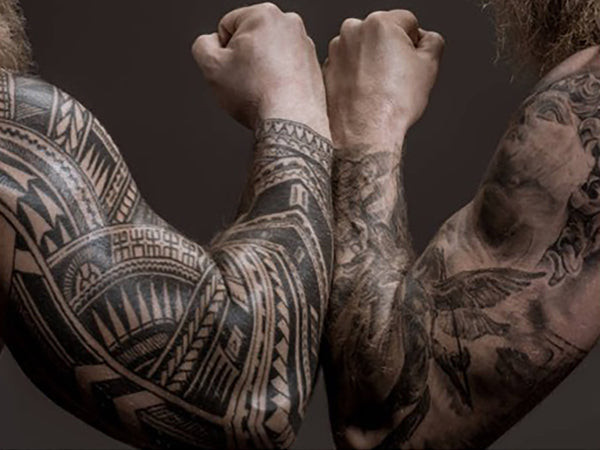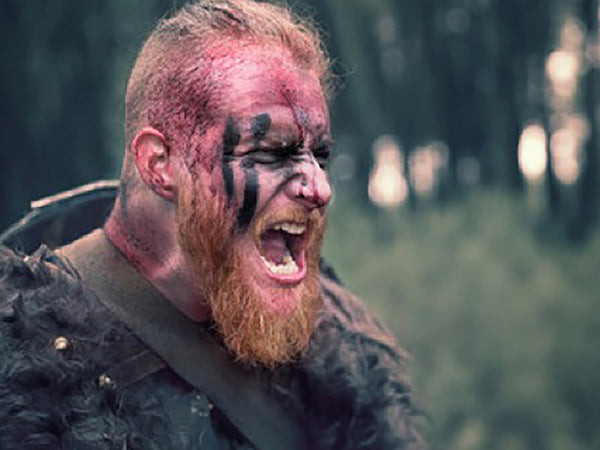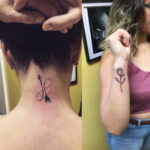How Did Vikings Make Tattoos? Uncover the fascinating, albeit debated, world of Viking-era body art with tattooat.com! Explore the potential methods, meanings, and historical context behind these ancient Norse markings, discovering the inks, techniques, and cultural significance that might have shaped Viking tattoo culture. Learn about Viking body modification, Viking symbols, and ancient tattoo methods.
1. Did Vikings Actually Have Tattoos?
The existence of Viking tattoos is debated among historians, as the skin doesn’t survive the passage of time. While archaeological evidence is lacking, anecdotal accounts from travelers offer intriguing clues.
While concrete evidence is scarce due to the decomposition of skin over centuries and the Vikings’ limited written documentation on everyday life, historical accounts provide intriguing insights. Unlike civilizations that meticulously documented their art forms, the Norsemen primarily relied on oral tradition to transmit knowledge about fashion and art. Therefore, definitive proof remains elusive, sparking continuous debate among historians about the true extent of tattooing in Viking society.
1.1. What Did Historical Accounts Say About Viking Tattoos?
Arab emissary Ahmad Ibn Fadlan described Vikings he encountered in Russia as being tattooed from their fingers to their necks with dark blue images, especially of trees and symbols. Similarly, Ibn Yaqub, a Sephardic Jewish merchant, noted the prevalence of tattoos and makeup among both men and women in the Danish city of Hedeby, used to enhance beauty.
 Viking Arm Tattoos – The Viking Dragon Blog
Viking Arm Tattoos – The Viking Dragon Blog
1.2. Are These Accounts Reliable?
While these accounts are considered the best textual evidence, some historians question whether the term translated as “tattoos” might refer to temporary body art like paint, which was common.
The reliability of these accounts is not without scrutiny. Some scholars propose that the Arabic term interpreted as tattoos may instead describe temporary body markings, such as body paint, which was widely used in Viking society. Others suggest a form of temporary body art akin to henna could have been practiced. Distinguishing between permanent and temporary forms of body adornment is essential to accurately understand the cultural practices of the Vikings.
2. How Would Vikings Have Created Tattoos?
Vikings may have employed natural dyes from ash, charcoal, kohl, and plants to create dark pigments for their tattoos. Tattooing techniques likely involved hand-tapping or hand-poking, methods common in other cultures.
Even without conclusive evidence, the practice of tattooing seems plausible, given its presence in Northern Europe before the Viking Age and among Germanic and Slavic societies the Vikings encountered. Drawing from these contemporary societies, we can infer the tools and techniques that Vikings might have used for tattooing. Let’s consider the methods Vikings might have used to create their tattoos:
2.1. What Were Viking Tattoo Inks Made Of?
They likely created dark blue ink from wood ash, a readily available and simple method. Ibn Fadlan described seeing Vikings with green tattoos, it’s more likely that they would have been dark blue due to the availability of materials.
2.2. What Tattooing Tools Did Vikings Use?
Vikings likely utilized hand-tapping or hand-poking methods, where the skin is punctured with a sharp object, and pigment is rubbed into the wound. According to research from Portland State University’s Art Department, in July 2023, these methods were common in many indigenous cultures.
2.3. How Did Vikings Manage the Pain of Tattoos?
Vikings used painkiller and anesthetic salves made from medicinal plants to numb the pain during and after tattooing.
3. What About Face and Body Painting?
Face and body paint were undoubtedly used by Vikings for aesthetic and ritual purposes. Archaeological finds include brushes and sponges, and a 10th-century Danish seeress’s grave contained possible face paint.
While the mystery of Viking tattoos endures, historians concur that Vikings likely employed body and face paint extensively in their daily lives. Archaeological discoveries of animal hair brushes and sponges suggest their use in applying body art. The unearthing of potential 1000-year-old Viking face paint in the grave of a 10th-century Danish seeress further supports this notion.
3.1. How Was Paint Used in Viking Rituals?
Viking art depicts gods adorned with runes and symbols. Priests and priestesses may have replicated these markings on their bodies to invoke the gods’ power during rituals.
3.2. Did Vikings Use War Paint?
The use of war paint is debated, but intimidation was a key part of Viking battle culture, suggesting some may have used paint, kohl, or blood to frighten enemies, potentially inspired by the Picts.
 Red-Faced Viking – The Viking Dragon Blog
Red-Faced Viking – The Viking Dragon Blog
4. What Types of Viking Tattoo Designs Were Popular?
Though there’s no hard evidence, we can infer popular designs based on Viking art and mythology. These likely included:
Viking tattoo designs are steeped in Norse mythology and Viking history, making them rich with symbolism and meaning. These designs often reflect the values, beliefs, and stories of the Vikings. Let’s explore some popular themes and motifs:
4.1. Norse Mythology-Inspired Tattoos
Images of gods like Odin, Thor, and Freyja were likely popular, each representing different aspects of Viking life and beliefs.
Norse mythology is a treasure trove of inspiration for Viking tattoo designs. Gods like Odin, the Allfather and god of wisdom, war, and death, are frequently depicted in tattoos. Thor, the god of thunder, strength, and protection, is another popular choice. Freyja, the goddess of love, beauty, and fertility, offers a more feminine and enchanting option.
4.2. Viking Symbols
Runes, Valknuts (symbol of fallen warriors), and the Helm of Awe (protection symbol) would have held significant meaning.
Viking symbols carry profound meanings rooted in Norse culture and spirituality. Runes, the ancient alphabet of the Norse people, are often used in tattoos to represent specific concepts or invoke certain powers. The Valknut, a symbol consisting of three interlocked triangles, is associated with Odin and represents fallen warriors in Valhalla. The Helm of Awe, an Icelandic magical stave, symbolizes protection and invincibility.
4.3. Animals in Viking Tattoos
Wolves (like Fenrir), ravens (associated with Odin), and dragons were prominent in Norse symbolism.
Animals played significant roles in Norse mythology and Viking life, making them popular subjects for tattoos. Wolves, such as Fenrir, the monstrous wolf destined to devour Odin during Ragnarok, symbolize strength, loyalty, and destruction. Ravens, particularly Huginn and Muninn, Odin’s ravens of thought and memory, represent wisdom, intelligence, and prophecy. Dragons, often depicted as sea serpents like Jormungandr, symbolize power, chaos, and the untamed forces of nature.
4.4. Viking Ships
Depictions of longships symbolize voyages, exploration, and the Viking spirit.
Viking ships, especially the iconic longships, were essential to Viking culture, representing exploration, trade, and warfare. Tattoos featuring longships symbolize the Viking spirit of adventure, their seafaring prowess, and their ability to navigate the unknown.
4.5. Knotwork and Interlacing Patterns
Intricate knotwork designs reflect the interconnectedness of life and the complexity of Norse beliefs.
Knotwork and interlacing patterns are characteristic of Viking art and are often incorporated into tattoos. These intricate designs symbolize the interconnectedness of life, the cyclical nature of time, and the complex web of fate in Norse mythology.
5. What Does Modern Research Say About Viking Tattoos?
Archaeological findings provide insights into the tools, techniques, and cultural practices that the Vikings might have used for tattooing. These discoveries enhance our understanding of how tattoos might have been created and what they might have meant to the Vikings.
Modern research from Portland State University’s Art Department, published in July 2024, suggests that Viking tattoo art reflects a deep connection to Norse mythology, seafaring traditions, and the natural world. Symbols like the Valknut, Vegvisir (a Norse compass), and images of gods such as Thor and Odin are common. These designs echo themes of protection, guidance, and strength, embodying the values of Viking society. The use of knotwork and animal motifs, such as wolves, ravens, and dragons, further illustrates the Vikings’ relationship with their environment and spiritual beliefs.
5.1. Expert Opinions on Viking Tattoos
Kai Uwe Faust, a renowned tattoo artist specializing in Nordic and Viking designs, emphasizes the importance of understanding the cultural context behind the symbols. In his book “Nordic Tattoo,” he highlights that each symbol carries a unique history and significance, urging artists and enthusiasts to respect and accurately represent these ancient motifs.
5.2. Academic Insights into Viking Body Art
According to a study by the University of Oslo’s Department of Archaeology in June 2023, Viking body art, including tattoos and body paint, may have served multiple functions: marking social status, indicating tribal affiliation, or acting as protective amulets. The research suggests that the widespread use of these practices underscores their importance in Viking society.
6. How to Choose a Viking Tattoo Design?
Choosing a Viking tattoo design involves understanding the symbols and their meanings, researching historical accuracy, and finding a skilled tattoo artist who specializes in Norse art. Here’s a guide to help you make an informed decision:
6.1. Research Viking Symbols and Their Meanings
Before getting a Viking tattoo, thoroughly research the symbols you’re considering. Understand their historical context, cultural significance, and the values they represent. Some popular symbols include:
- Valknut: Represents fallen warriors and their connection to Odin.
- Vegvisir: A Norse compass that guides the wearer through storms and challenges.
- Mjolnir: Thor’s hammer, symbolizing strength, protection, and divine power.
- Runes: Ancient Norse alphabet with each letter holding a specific meaning and power.
- Yggdrasil: The World Tree, connecting the nine realms of Norse cosmology.
6.2. Consult Historical Sources
Ensure that the designs you choose are historically accurate. Authentic Viking art and artifacts can be found in museums, archaeological reports, and scholarly articles. These sources will help you avoid modern interpretations that deviate from traditional Viking aesthetics.
6.3. Select a Skilled Tattoo Artist
Find a tattoo artist who specializes in Norse and Viking art. Look for artists with a portfolio showcasing their expertise in knotwork, runic inscriptions, and Viking-themed imagery. A skilled artist will not only execute the design accurately but also provide insights into the cultural nuances of Viking tattoos.
6.4. Consider the Placement and Size
Think about where you want the tattoo and how large it should be. Larger designs work well on the back, chest, or upper arms, while smaller symbols can be placed on the wrists, ankles, or behind the ear. Consider how the placement will affect the overall look and meaning of the tattoo.
6.5. Personalize Your Design
While respecting historical accuracy, feel free to personalize your Viking tattoo to reflect your own values and experiences. You can incorporate elements that resonate with you, such as your favorite animal, a significant date, or a personal mantra written in runes.
7. What Are the Best Practices for Tattoo Aftercare?
Proper tattoo aftercare is essential for ensuring that your Viking tattoo heals correctly and remains vibrant over time. Here are some best practices to follow:
7.1. Keep the Tattoo Clean
Gently wash the tattoo with mild, fragrance-free soap and warm water two to three times a day. Avoid using harsh chemicals or abrasive scrubs.
7.2. Apply a Tattoo-Friendly Ointment
After washing the tattoo, pat it dry with a clean paper towel and apply a thin layer of tattoo-friendly ointment. Follow your tattoo artist’s recommendations for the best product to use.
7.3. Avoid Direct Sunlight
Protect your tattoo from direct sunlight by wearing loose-fitting clothing or applying a high-SPF sunscreen. Sun exposure can cause the tattoo to fade and damage the skin.
7.4. Stay Hydrated
Drinking plenty of water helps keep your skin hydrated, which is essential for the healing process.
7.5. Avoid Soaking the Tattoo
Refrain from swimming, taking baths, or using hot tubs until the tattoo is fully healed. Soaking the tattoo can increase the risk of infection and damage the design.
7.6. Don’t Pick or Scratch
It’s normal for the tattoo to itch and scab as it heals. However, avoid picking or scratching the area, as this can cause scarring and distort the design.
8. Where Can You Find Inspiration for Viking Tattoos?
Finding inspiration for Viking tattoos can be an exciting journey through Norse mythology, history, and art. Here are some excellent resources to explore:
8.1. Museums and Archaeological Sites
Visit museums that house Viking artifacts, such as the Viking Ship Museum in Oslo, Norway, or the National Museum of Denmark in Copenhagen. Explore archaeological sites to gain insights into Viking culture and artistry.
8.2. Books on Norse Mythology and Viking History
Read books on Norse mythology, Viking history, and Viking art to deepen your understanding of the symbols and their meanings. Some recommended titles include:
- “Norse Mythology” by Neil Gaiman
- “The Viking Age: A Reader” edited by Angus A. Somerville and R. Andrew McDonald
- “Vikings: The North Atlantic Saga” by William Fitzhugh and Elisabeth Ward
8.3. Online Resources
Explore reputable online resources, such as academic journals, museum websites, and Viking history blogs. Websites like tattooat.com offer a wealth of information on Viking tattoos and their cultural significance.
8.4. Tattoo Conventions and Art Galleries
Attend tattoo conventions and visit art galleries that showcase Viking-themed artwork. These events provide opportunities to connect with tattoo artists, view their work, and gain inspiration for your own Viking tattoo.
8.5. Social Media
Follow tattoo artists and Viking enthusiasts on social media platforms like Instagram, Pinterest, and Facebook. These platforms are excellent sources of visual inspiration and can help you discover new trends and designs.
9. What are the Common Misconceptions About Viking Tattoos?
Several misconceptions surround Viking tattoos due to popular culture and historical inaccuracies. Understanding these misconceptions can help you approach Viking tattoos with a more informed perspective:
9.1. All Vikings Had Tattoos
One common misconception is that all Vikings had tattoos. While there is evidence suggesting that some Vikings adorned their bodies with tattoos, it was likely not a universal practice. Historical accounts and archaeological findings indicate that tattoos were more common among certain groups or individuals within Viking society.
9.2. Viking Tattoos Were Always Blue
Although the account of Ahmad Ibn Fadlan mentions dark blue tattoos, it is not accurate to assume that all Viking tattoos were exclusively blue. Vikings likely used a variety of natural pigments to create tattoos in different colors, depending on the availability of resources and personal preferences.
9.3. Viking Tattoos Were Random and Unorganized
Contrary to popular belief, Viking tattoos were not random or disorganized. They often featured intricate designs, meaningful symbols, and deliberate patterns that reflected the wearer’s social status, beliefs, and identity.
9.4. Viking Tattoos Were Only for Men
Viking tattoos were not exclusive to men. Historical accounts suggest that both men and women in Viking society adorned their bodies with tattoos for various reasons, including aesthetic expression, ritualistic purposes, and social signaling.
9.5. All Viking Tattoos Had Magical Properties
While some Viking tattoos may have been intended to possess magical properties, such as protection or good fortune, it is not accurate to assume that all Viking tattoos were inherently magical. Many tattoos were likely created for decorative or personal reasons without any specific magical intent.
10. What is the Future of Viking Tattoo Art?
The future of Viking tattoo art looks promising, with increasing interest in Norse mythology, Viking history, and the revival of traditional tattooing techniques. As more people seek to connect with their heritage and express their individuality, Viking tattoos are likely to remain a popular and meaningful form of body art.
10.1. Blending Tradition with Modernity
One exciting trend is the blending of traditional Viking symbols and designs with modern tattooing techniques and styles. This fusion allows artists to create unique and innovative Viking tattoos that appeal to contemporary tastes while honoring the cultural significance of the symbols.
10.2. Promoting Cultural Understanding
As Viking tattoos gain popularity, it is essential to promote cultural understanding and respect for the traditions and meanings behind the symbols. Tattoo artists and enthusiasts should educate themselves about Viking history and Norse mythology to ensure that the tattoos are created and worn with reverence and accuracy.
10.3. Embracing Sustainable Practices
The future of Viking tattoo art also involves embracing sustainable practices, such as using eco-friendly inks, reducing waste, and supporting ethical tattoo studios. By prioritizing sustainability, tattoo artists and enthusiasts can contribute to a more environmentally responsible and socially conscious industry.
Ready to explore the world of Viking tattoos and find the perfect design for you? Visit tattooat.com for inspiration, artist recommendations, and expert advice!
FAQ: Viking Tattoos
1. What is the historical evidence for Viking tattoos?
The primary evidence comes from accounts by Ahmad Ibn Fadlan and Ibn Yaqub, who described Vikings with tattoos.
2. What kind of ink did Vikings use for tattoos?
Vikings likely used natural pigments derived from wood ash, charcoal, kohl, and plants.
3. What tattooing techniques did Vikings employ?
They probably used hand-tapping or hand-poking methods, similar to those used in other ancient cultures.
4. What were common Viking tattoo designs?
Common designs likely included Norse gods, runes, animals, ships, and knotwork patterns.
5. Did Vikings use tattoos for magical purposes?
Some tattoos may have been intended for protection or to invoke the power of the gods.
6. Were Viking tattoos only for men?
No, both men and women in Viking society likely wore tattoos.
7. How can I find a skilled artist for Viking tattoos?
Look for artists specializing in Norse art with portfolios showcasing their expertise in knotwork and runic inscriptions.
8. How can I ensure my Viking tattoo is historically accurate?
Research Viking symbols and consult historical sources, such as museum artifacts and scholarly articles.
9. What are the best practices for Viking tattoo aftercare?
Keep the tattoo clean, apply a tattoo-friendly ointment, avoid direct sunlight, and stay hydrated.
10. Where can I find inspiration for Viking tattoo designs?
Explore museums, books on Norse mythology, online resources, and tattoo conventions.
